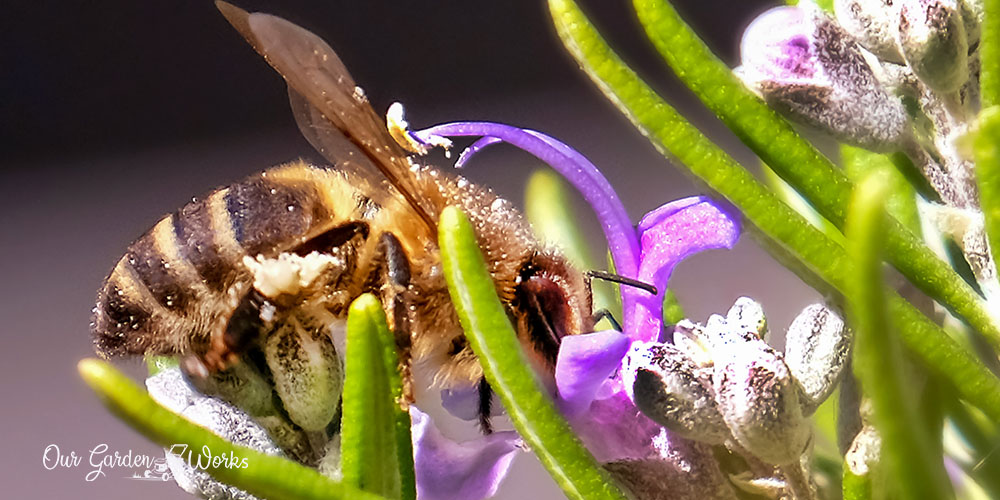Herbs have intense aromas that are usually used to drive away unwanted pests. So, it’s only natural to wonder: does rosemary attract bees or it drives them away like mint?
The beauty of knowing the answer to such a trivial but important question will equip you with knowledge that can enhance the ecosystem in your garden.
Bees are among the top pollinators in the world. According to the USDA, honey bees alone pollinate around 80% of flowering plants. They play a major role in the fruit development of crops and without them our food supply would suffer.
Even in your small home garden, the absence of these beneficial pollinators will gravely affect how your flowering plants bloom and your vegetables transition from flowering to fruit development.
In this post, discover if rosemary is a bee magnet or repellent and learn how to strategically place them in the garden.
Q: Does Rosemary Attract Bees?
Unlike other herbs, the purple flowers of rosemary attract different types of bees. Though rosemary is cultivated for its aromatic leaves, it produces tiny purple flowers that invite beneficial pollinators into your garden. The different bees include:
- Mason bees.
- Mining bees.
- Flower bees.
- Bumble bees.
- Honey bees.
Rosemary flowers can grow up to a quarter of an inch which can draw big and small types of bees, even the giant bumble bees.
It is a versatile herb where its flowers appeal to several insects and birds. Most gardeners love rosemary since it feeds both humans and beneficial insects and simply makes your garden smell earthy and aromatic.
Other pollinators like butterflies, hoverflies, and other nectar-feeding flies are also attracted to rosemary. Regardless if there’s a shortage of bee population in your area, you can rest assured that beneficial insects will still visit your herb garden.
Along rosemary, here are the other herbs that will surely make bees a common visitor in your garden:
- Thyme.
- Lavender.
- Oregano.
- Comfrey.
- Lemon balm.
What makes rosemary attractive to bees?
Aside from being a bee-friendly plant, rosemary possesses the following features that makes bees naturally attracted to it.
#1 Rosemary blooms early in the season
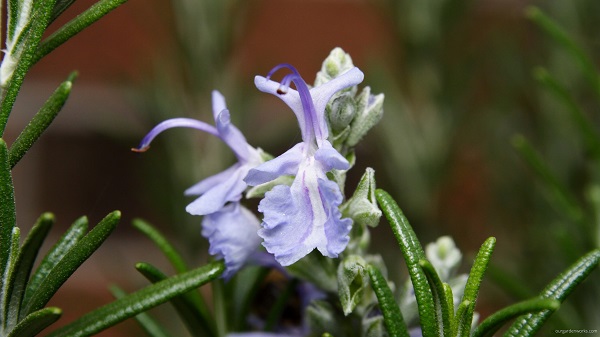
Rosemary can handle mild winters and can grow up to a shrub outdoors at not less than 10℉-20℉.
In areas with cold winters, they are best grown indoors. They develop blooms as early as February or in the late spring season which helps feed emerging spring bees like mason and bumble bees.
Rosemary saves the bees during the start of the winter season when the food supply for bees is few. It can bloom several times throughout the growing season and one of which is during spring and some cold-tolerant varieties grow in late summer up to winter.
#2 Rosemary flowers blooms longer
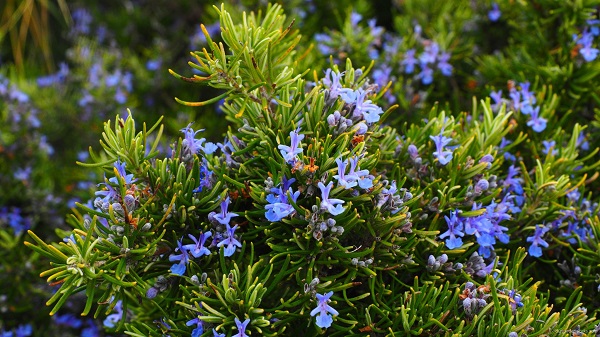
Bees and beneficial insects not only love rosemary because it’s an early bloomer but also it blooms longer than other herbs.
Rosemary blooms in late spring up to early summer. Its long blooming window feeds the bees and insects with a short foraging window and helps them survive in the wild.
#3 Bees gain a protective benefit from the nectar of rosemary flowers
Herbs like rosemary contain a lot of antimicrobial and antifungal properties that not only help humans but also bee colonies.
Varroa mites are a common bee parasite that infests honey bee hives and kills bees. With the help of the medicinal properties from the nectar of herbs, bees are noticed to be using them for self-medication.
According to a study, the nectar of rosemary contains one of the four essential oils that can help naturally kill varroa mites in bees.
By planting rosemary in your herb garden, you’re not only feeding the bees but also keeping them safe from deadly bee pests and diseases.
#4 Good addition to pollinator-dependent crops
Some crops are heavily-dependent on insects to pollinate its flowers and produce fruit.
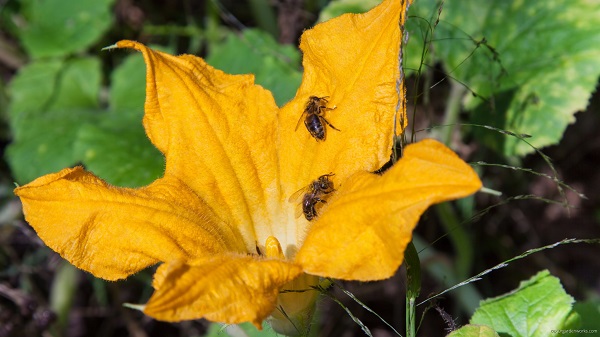
One example is pumpkin, which only produces female flowers after the male ones which die eventually. So, during that time frame, the pollinators have a short time window to pollinate the flowers.
Gardeners use pollinator magnets like rosemary and other flowering plants to increase the chances of pollinating pumpkin flowers. They are usually placed around the pumpkin plant during their blooming season until the pumpkin fruits develop.
If there are no pollinators around, gardeners usually hand pollinate the flowers to intervene in the pollination process.
Use and culinary benefits of rosemary
Rosemary is surely a good addition to your garden and a safe plant for bees. However, its benefits not only stay in the garden as a plant but also as a culinary and medicinal herb that contributes to flavor and nutrition of our food.
Rosemary as an herb
Rosemary leaves have an earthy flavor that gives a bland dressing or marinade a new twist. Used as an aromatic in the kitchen, dried and fresh rosemary can be used for the following:
Herb and garlic infused oil
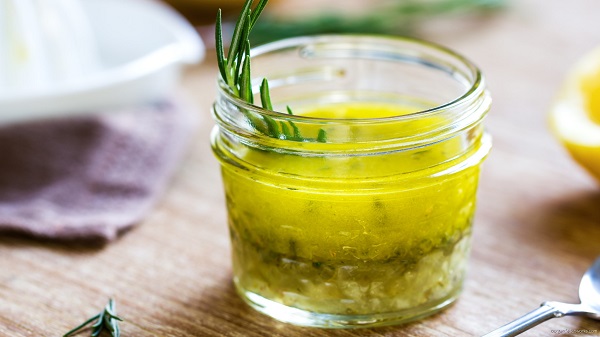
Who doesn’t love a flavorful olive oil added to bread or pasta? If you want a quick pick-me-up dressing for our salad or filling for your sourdough or focaccia, an herb infused olive oil may come in handy.
Here’s how to make one at home:
- Mix 3 to 4 cloves of garlic and 2 to 3 sprigs of fresh rosemary in a pot. Add 300ml to 500ml olive oil. Make sure that the cloves and rosemary are submerged in oil.
- Put the pot in low heat and let the oil simmer for 10 to 20 minutes until the flavor is extracted.
- Let the oil cool down and transfer it to airtight bottles. You may add fresh rosemary in the bottle before pouring the oil or use the ones from the pot.
- The herb infused oil can be flexibly used on any type of dish. Store the bottle away from direct sun, preferably in the fridge or in the condiment cabinet.
Soup flavoring
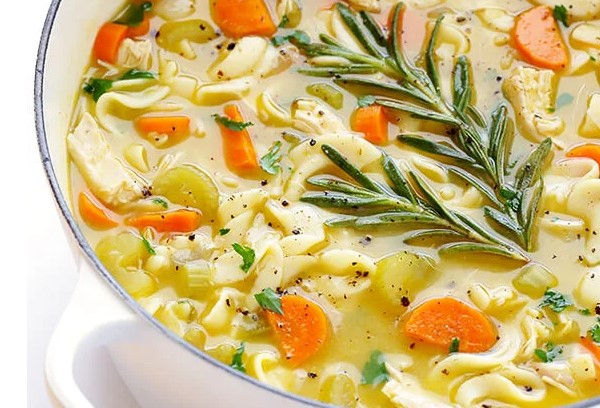
Rosemary is a great addition to soups, especially with chicken and potatoes. It also goes well in plain pumpkin or tomato soup which levels up their flavor and nutrition. Here are some recipes that you can try:
- Rosemary chicken noodle soup.
- Roasted tomato rosemary soup.
- Creamy potato with rosemary soup.
- Lemon and rosemary chicken soup.
Chicken marinade
You’re missing half of your life if you haven’t tried rosemary chicken or grilled chicken marinated in rosemary sauce. They are easy recipes you can use for your chicken meat that is also healthy for the body.

Here’s how you can make rosemary chicken:
- Cover chicken breasts with salt and pepper and sear it in olive oil until brown. Set aside once done.
- In a baking dish add melted butter, chicken broth, 2 to 3 sprigs of fresh rosemary, and garlic. You may also add carrots or potatoes.
- Place the seared chicken breasts in a baking dish and bake it until they become tender and flavorful.
- Pour the juice over the chicken and it’s ready to serve.
Tea
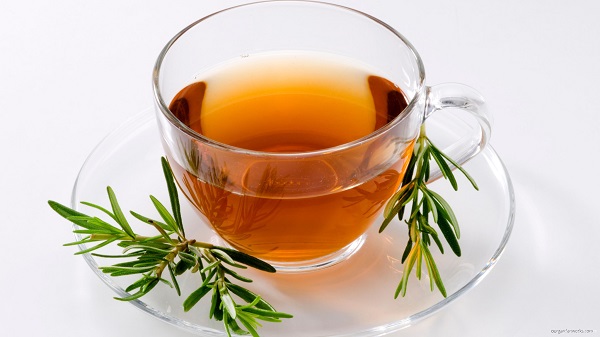
Rosemary is also an ideal option for tea. It is known as a relaxing tea that helps ease anxiety and stress.
It is also packed with a lot of healthy compounds which are used in some countries as a medicine for some illnesses.
Rosemary as a medicine
Rosemary is packed with nutrients and powerful antimicrobial properties that help boost the immune system.
Here are some of the health benefits that you can expect from a cup of rosemary tea:
- Rich source of antioxidants.
- Anti Inflammatory properties that help prevent heart disease and diabetes.
- Immune system booster and blood circulation enhancer.
- Cognitive stimulant.
- Memory and focus enhancer.
- Lowers blood sugar levels.
- Vision protection and eye health booster.
How to grow a rosemary herb
Rosemary is drought tolerant and a natural rabbit repellent. It can live for 30 years and can be extremely drought tolerant.
In some parts of the world, it is considered an invasive species. Like any other plant, there are several varieties of rosemary that you choose from.
Check out how to grow your rosemary at home:
#1 Choose a rosemary variety
Rosemary has several varieties where some can reach for up to 4 feet and some stay at 1 to 2 feet. However, the most ideal basis in choosing a rosemary variety is the climate in your region.
There are cold hardy and frost sensitive rosemary varieties which include:
Cold hardy rosemary varieties
- Arp: grow up to 4 feet and withstand temperatures at -4℉.
- Alcalde: grow in sub-zero temperatures but can only grow up to 3 feet.
- Madalene Hill: survives in 0℉ and a popular snack of bees during spring.
- Athens Blue Spire: rare rosemary variety that can thrive in temperatures -5℉ to -10℉.
Warm-loving rosemary varieties
- Tuscan blue rosemary: blooms in several seasons and provides food for insects during off-seasons.
- Blue spires: ideal for landscape design due to its formal look in the garden that resembles a mini Italian cypress.
- Prostratus: grows up to two feet and is often used as a ground cover or an option for cascading down walls.
- Collingwood Ingram: produces generous leaves that hides its woody stems and an ideal option for slopes surrounded by drought-tolerant shrubs.
#2 Help it establish on its pot
Rosemary grows best through cuttings rather than from seed. Their soil requirement is a neutral soil with a soil pH level of 6.0 to 7.0 and less moisture-retaining materials. You may use a soil pH meter to adjust the soil acidity for your rosemary.
Pro tip: If your garden soil or potting soil is too acidic (5.0 and below), you may add agricultural lime. However, if it’s too alkaline(7.5 and above), you may add sulfur or blood meal. Food scraps like egg shells are also efficient in neutralizing the acidity in the soil while adding nutrients like calcium for plants.
With the fibrous roots of rosemary, you should plant them at a distance of 2 to 3 feet apart. Rosemary are more fond of container-growing environments, so you may plant them on pots or in plant boxes.
#3 Give adequate water and sun exposure
As a Mediterranean herb, rosemary can withstand direct sun and thrives in warm climates. They are drought tolerant and can tolerate neglect rather than being overwatered.
Around 6 to 8 hours of sun is needed for their optimal growth, especially during their vegetative stage of leaf-growing stage.
#4 Mulch and prune when needed
Rosemary is not a fan of extreme temperatures. It will require some protection from the intense summer heat and the freezing temperatures of winter.
Applying mulch can help it retain soil moisture longer and serve as an insulation during winter.
Most gardeners prune old rosemary stems to help trigger the development of better and more leaves.
Usually, it produces better and more flavorful leaves when pruned regularly. Just make sure to not prune more ⅓ of the plant to avoid pruning stress.
#5 Pest and disease control and root rot
If bees and other beneficial insects love rosemary leaves, then pests are also in the game. Healthy rosemary plants can resist mild pest infestations.
However, when they experience stress, the damage can manifest on their emerald green leaves. Here are some of the pests that you should watch out for:
- Whiteflies.
- Spider mites.
- Scales.
- Mealybugs.
- Powdery mildew.
- Root rot.
Usually, you can splash water on white flies. However, tough pests like scales and mealybugs may require a spray of diluted neem oil in the morning or late afternoon.
Other than pests, root rot is another condition you should keep in mind because rosemary varieties are very susceptible to it. Some varieties are more prone to root rot than others like Ken Taylor.
Frequently Asked Questions (FAQs)
Which rosemary variety do bees like the most?
Bees are drawn to most rosemary varieties but it is significantly fond of the creeping rosemary or Rosmarinus officinalis. It is the type of rosemary that most of us are familiar with. Bees like it because of its big and open blooms which makes it easier for them to get nectar.
What are the herbs that bees hate?
Since rosemary is an herb, you’re probably compelled to place other herbs next to it. However, some of them can drive bees away such as:
- Basil.
- Eucalyptus.
- Mint.
- Peppermint.
- Wormwood.
- Citronella.
How long does rosemary take to bloom?
Rosemary blooms several times a year. It takes them around 6 to 12 months to fully mature and develop first blooms. Once they start blooming, they will continuously repeat bloom for the next coming years.
Final Thoughts
So, does rosemary attract bees? Definitely yes!
Having rosemary is such a blessing in your garden since you attract pollinators, enjoy earthy scents, and have freshly picked rosemary leaves within your reach.
Let us know in the comments how much you love rosemary and how it helps improve your garden.
Also, please share this with your friends who love herbs and encourage them to grow an herb garden of their own.
